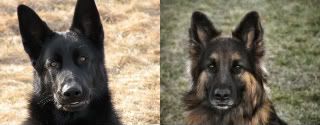From the first article:
"Central to this belief is the concept that a wolf pack consists of individuals continually competing for higher rank but ultimately held in check by the alpha male and alpha female."
This is not true.
Wolves, like dogs, are born with temperament qualities that determine the amount of push and shove within the pack. The rank drive. Some dogs have strong rank drive, they are dominant animals. Some do not, they are betas or omegas by nature not because they have been beaten down. This is the same for dogs. The difference is that humans don't care, they mesh together packs based not on the natural compatability of the canines involved, they often just like Fluffy and Fido for their looks and individual temperament without understanding that having too many dominant individuals in one pack is not ideal or natural. In an ideal pack there are many types of wolves. One thing that is often missing in domesticated "packs" is the omega. Omegas act to calm the pack and cool heated or aggressive situations, they are the peacemaker and the peacekeeper with or without the alpha's presence. The omega will even calm the alpha and prevent the alpha from fighting. So combine the lack of peacekeeper with having an unnatural situation of multiple dominant/rank driven animals in one household you have an issue.
Not to say that most dogs that are called dominant really are. Rank drive comes in levels like all other drives.
In wild settings, a dominant youngster leaves to form its own pack, take over another pack, or vies for the top possition within its own.
In the wild it often happens that dominant individuals are not born or mature at the same time to create the situations we see in captivity. As listed in the first article the examples of the captive kept wolves the fights between mature males and females. I will say that in the wild it would not have happened - the reason is there is plenty of territory to move to or claim. Captive animals are contained in one territory with no options for leaving and are forced into confrontations because of this.
Regarding Mech's findings - that would be thanks to the environment of those wolves. The tundra wolves are a subspecies and the environment they live in dictates mating and pack behavior. The population is far more spread out, strength in numbers is not as important or necessary to hold a territory. Also, the amount of prey widely available affects pack size as well. If the prey is just not available to sustain large packs in one territory it makes sense for there to rather be several small family packs over a larger area. Much like the social structure of foxes.
Lowland wolves (lower 48) have a greater source of prey, supporting larger packs which then claim and maintain larger territories. No matter the location, in social interaction a hierarchy is noted, the only difference is how often these social interactions actually take place.
Feral dogs are often not that way from pups. Pups do not survive in a majority of instances unless aided by humans. So these dogs that become wild likely did so while adults or at least past weaning/8weeks. The human factor comes into play here. What was done during the development of the dogs to cause a more anti social behavior pattern? The lack of a need to hunt combined with the wid variation in temperament and drive type in the domestic dog also plays a part. Wolves do not lack drive - lacking necessary drive means they do not survive. Dogs can be high drive, low drive, bred to be very social(foxhounds, labs) bred to be independent(northern/spitz breeds)
I don't have time to read the other articles right now but I will. The differences in breed temperaments and types is not because of the dogs themselves or that domestication is what "caused" it. Humans selected for it. Breeds are the way they are because humans control their breeding and have selected the traits they most liked to be further developed.
Wolves are not exactly like dogs, not all wolves are exactly alike. Dogs are not exactly like wolves nor are all dogs exactly alike. When I work with any dog I deal with the behavior based on the dog I am currently at that very moment working with AND the environment its in. The way a dog has been raised and handled helps me determin the proper course of action and often provides explanation for the behavior I am retraining.
Jeff, when it comes to dogs, horses, cats, whathaveyou. Animals. Personal experience should make up a LOT of your basis for theory or philosophy of training or behavior. If you have not seen it yourself, dealt with it yourself then you reall have no idea. You cannot read about these things in a book and think you know how things are and will be based on a list of facts and figures that someone else put together that is probably not from personal experience either. When it comes to living thinking creatures you have to be active and reactive with learning and handling them.
A dog is not a book. It is not an essay or a theory or a scientific thesis.
 Previous Topic
Previous Topic Index
Index Next Topic
Next Topic













 Top
Top




.jpg)
